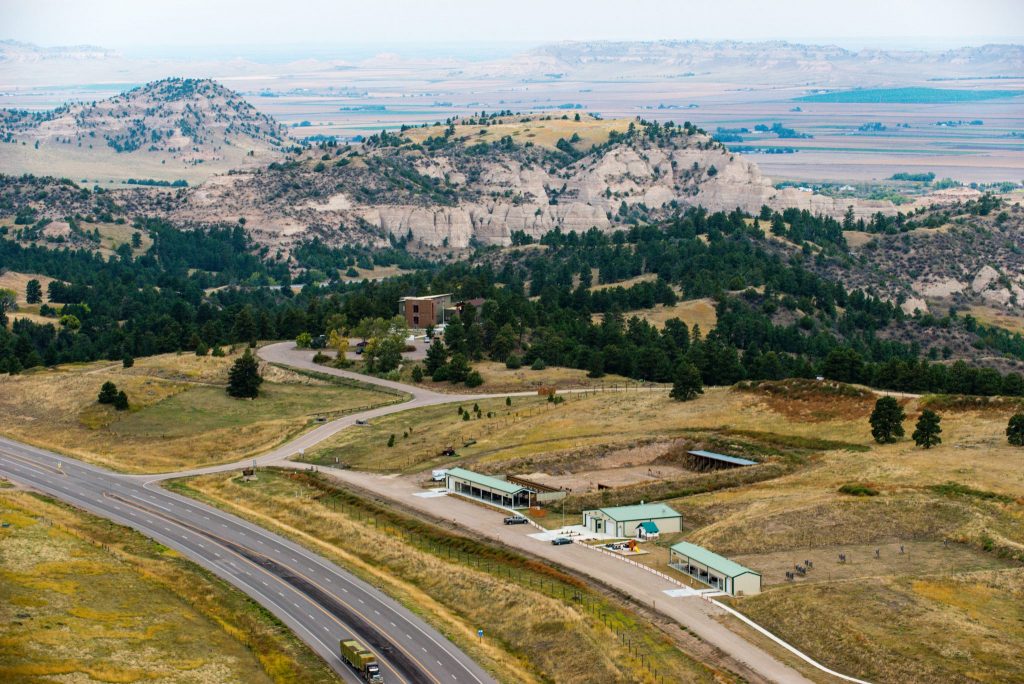
By Justin Haag
High on the list of Nebraska’s captivating scenery and natural assets are the Wildcat Hills. It seems an understatement to label this topographical spectacle as “hills,” as it is actually a land of rugged buttes, ridges and canyons with topographical elements rising upwards to 1,000 feet above the North Platte Valley. Some of the state’s most recognizable landforms – Chimney Rock, Scotts Bluff, Court House and Jail Rocks – are part of this region.
Along Nebraska Highway 71 just 10 miles south of Gering, in the upper elevations of the Wildcat Hills, a special property highlights the best of what this region has to offer. Thanks to the Wildcat Hills State Recreation Area, thousands have developed an appreciation for the region’s natural resources, paleontology and recreational opportunities.
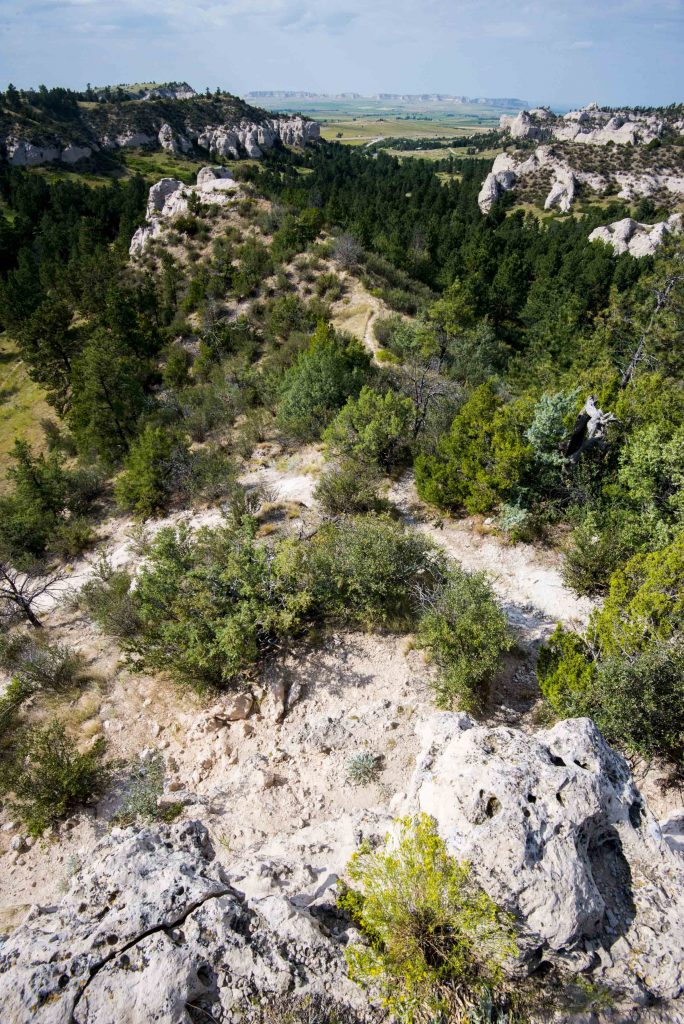
The recently renovated and expanded Nature Center with its interactive displays and event space have been a big hit among visitors, as has the new shooting complex that features targets for a variety of firearms and archery equipment. They are among the Nebraska Game and Parks Commission’s most modern facilities.
In addition to those facilities, 1,094 acres of wilderness just outside the doors help visitors get in touch with nature. Many have grown to love the park’s rugged pine-studded topography, along with a stunning view of Scotts Bluff and the North Platte Valley.
Camping, picnicking, hiking and biking are just a few of the activities available for visitors. Perhaps most of all, it is a great place to take the kids.
An Expanding Mission
No doubt, this property has changed since the Commission acquired the initial Wildcat Hills tract in 1929. Once home to captive bison and elk herds, the property has evolved along with the public’s wishes.
Visitors realize they are in a special place as they walk into the Nature Center, the park’s headquarters, and encounter the branches of a replica 27-foot ponderosa pine tree rising from the garden level through a hole in the main floor to the vaulted ceiling.
While the property maintains wilderness appeal, the center’s wide range of indoor interpretive displays and programs also highlight nature.
Spearheaded by a team of local visionaries, the Wildcat Hills Nature Center was constructed in the early 1990s. Building on the success of that venture, donor support led to a major expansion of 8,720 square feet, more than doubling the size of the original 5,300-square-foot structure. The expanded facility, with new areas for meetings, instruction and displays, opened in spring 2017.

Taking a Shot
Early this decade, Commission officials recognized an opportunity, and a need, to promote and facilitate shooting sports in a family-friendly environment. The adjacent wildlife management area had become a popular place for area residents looking for a place to practice shooting.
The Wildcat Hills Shooting Sports Complex, which opened fall 2016 and is easily seen and accessed from the highway, features targets for a variety of firearms and archery equipment.
The offerings include a small-bore range for rimfire rifles and approved handguns, a pellet range with bull’s-eye targets and a state-of-the-art shooting gallery, an archery range with bull’s-eye and 3-D targets, a shotgun trap range, and a 100-yard range for sighting in rifles and precision shooting. A 5-stand sporting clays range and skeet range are nearing completion.
People may bring approved firearms and bows for all but the air rifle range, which requires use of the complex’s guns. Equipment, including firearms, ammunition, bows and arrows are available for rental, and trained instructors help people get started.
The facility not only serves experts, but also introduces youth and novices to shooting sports and consequently promotes the state’s hunting heritage.
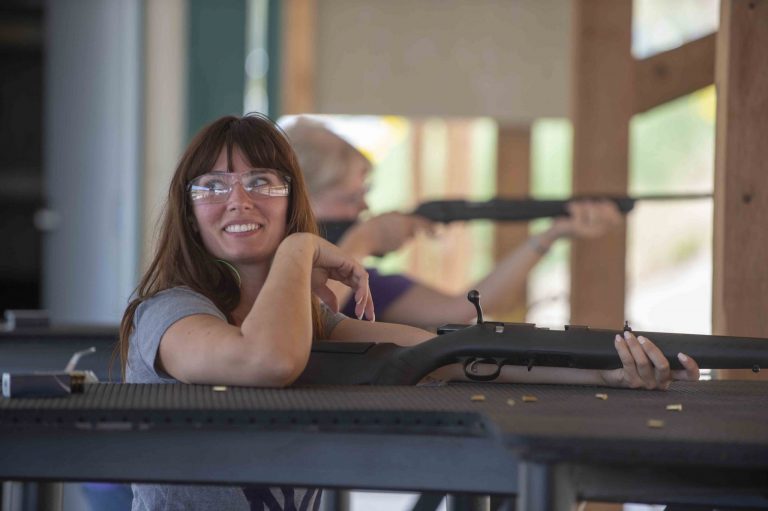
Learning, Naturally
One of Wildcat Hills’ paramount missions is to combat “nature deficit disorder,” the evidence-based idea that children and others are spending less time outdoors.
More than 6,000 children annually take part in education programs at the Nature Center. It is especially popular during field trip season in spring.
Second-grade teacher Erica Croft of Morrill is among the educators using the center to complement the curriculum. She and her teaching partner find the center and its services helpful in expanding students’ knowledge of their environment.
“Many of our students have only been to school and to Scottsbluff, so venturing into the great outdoors is a new experience for a lot of them,” she said. “The facility itself offers a unique, multisensory learning environment. They could look at fossils, bones and habitat recreations. They could create footprints in sand with molds. They could look at slides under microscopes and even touch real life animals.”
Three-dimensional elements, such as taxidermy and fossils, provide outstanding visuals, as do painted murals of the region’s current ecosystem and how scientists believe it looked in prehistoric times.
The new classroom provides a comfortable area to conduct educational activities. Live amphibians and reptiles, including a Blanding’s turtle and western hognose snake, give children an opportunity to see species first-hand.
“During the school year, we study different habitats and ecosystems, so this field trip is a nice complement to our studies,” Croft said. “It puts the ‘theoretical’ learning into everyday, tangible experiences for the kids. They get to see what the prairie looks like, experience the sounds and the smells, see bugs, animals, etc.”
Most of the field trips are led by Amanda Filipi, a Commission outdoor education specialist who serves the Panhandle.
“Amanda does an amazing job working and communicating with the kids,” Croft said. “She has a talent of talking to them like they are mature, but also really injecting a lot of humor into all of the facts that she is presenting. This isn’t always an easy skill when working with 7- and 8-year-olds.”
In early May, for the second consecutive year, the center opened its doors to hundreds of students for the annual Outdoor Discovery Program – a Commission event that introduces children to nature and a wide variety of outdoor activities. The Wildcat Hills facilities were inadequate before the latest round of construction and expansion, so it was previously staged at the Trails West YMCA Camp in Scottsbluff.
Also for young visitors, the Junior Explorer program features a 16-page full-color book with activities. The program has activities requiring children to find and study natural features, such as animal tracks and plants. The program has a definite Wildcat Hills flavor, with topics specific to the area.
The center also plays host to Wildcat Weekends, a series of monthly educational events each with a different theme targeted to the general population.
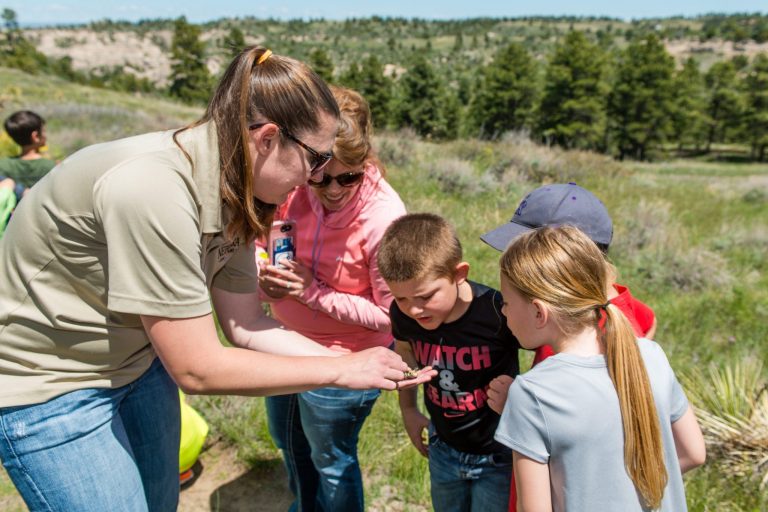
Nature on Display
Perhaps one of the greatest attributes of Wildcat Hills is that visitors are never certain what they might see. Whether one is hiking more than three miles of trails, or taking in an unrivaled view of the valley on one of the nature center’s observation decks situated above the pines, the park is a visual treat.
A road along the park’s summit links visitors to trails coursing through evergreen-studded ridges and canyons that feature mountain mahogany and other western plant species.
The park attracts a lot of wildlife, and it has become recognized as a premier bird-watching site. Well-stocked feeders near the center’s dark tinted windows allow visitors to observe the wide variety of avian species, such as red crossbills and pine siskins, from the comforts of indoors. In fall, park visitors get an up-close view of feathered species at a bird-banding station operated by the Bird Conservancy of the Rockies.
An active indoor honeybee hive with transparent walls allows the busy insects to come and go while giving observers special insight to their work.
Wild turkeys, deer, bobcat and coyotes frequent the park, and there are even sometimes reports of bighorn sheep – if not at the park, they can be found at one of the many public lands nearby. Even the occasional moose has been reported on the property. Visitors are reminded to keep an eye out for another important member of the High Plains ecosystem, the prairie rattlesnake.
Way Back Wildcats
The Wildcat Hills Nature Center serves as an important stop and southernmost point of the Fossil Freeway, a corridor of seven important paleontological sites that extends northward to the Mammoth Site at Hot Springs, S.D.
Wildcat Hills is the site of the Millenium’s End Quarry, a remarkable trove of diverse fossils representing life 23 million years ago that was discovered on the highway right-of-way in 1999.
Past species such as the “bear dog” Ysengrinia and Prosynthetroceras, a deer-like animal with a slingshot-like horn protruding from its snout, are brought to life in an interpretive mural by artist Jan Vriesen.
Appropriate for a facility with “Wildcat” in its name, a 25-million-year old fossil of two battling saber-toothed cats entangled in death is housed in the center. Renowned paleontologist Loren Eiseley discovered it in the Panhandle in 1932.
A Place to Gather
With the 2017 expansion, the Nature Center gained a greater capacity to host groups.
The Ponderosa Room is designed to be an ideal location for meetings, reunions, birthday parties and small weddings. It seats 125 people in rows or 72 at tables and chairs.
Those who prefer to gather outdoors can capitalize on some of the park’s historical features. Dating back to the park’s earliest days are three Great Depression-era stone shelters that were constructed by the Civilian Conservation Corps and Works Progress Administration. The shelters are available on a first-come, first-served basis. The largest of the three accommodates about 40 people and has fireplaces on each end. The other two, which each have a picnic table and fireplace, are ideal for smaller groups.
The park has a camping area with 12 non-reservable sites for those who do not mind limited amenities, and an area on the east side of the park has recently been developed into a camping area for larger groups, such as scout troops. Take note, though, the areas are not accessible with large RVs and trailers because of sharp turn-arounds.
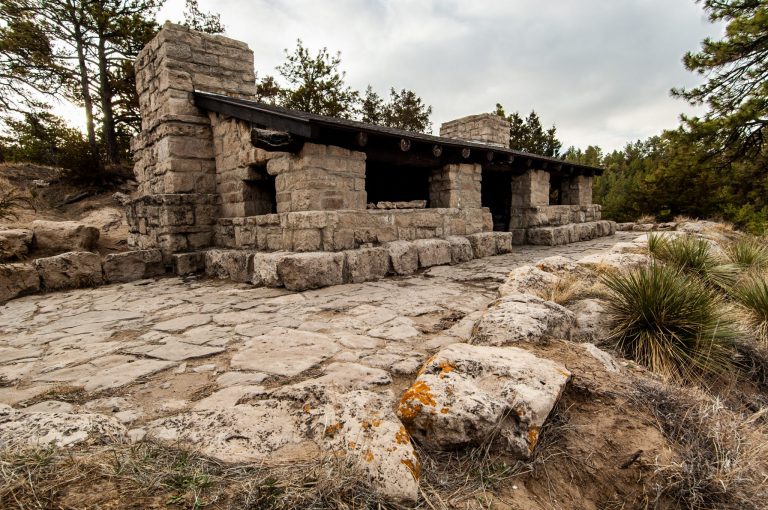
Hiking into the Future
No doubt, the new facilities have increased the park’s popularity. The estimated 35,000 visitors each year represent a 40-percent increase from before the nature center expansion and shooting complex construction. In addition, park staff continues developing valuable programs and improving the park’s environment.
Gary Shoemaker, the park superintendent since 2016, is a former employee of the Boy Scouts of America and has used connections from his past job to improve the park. More than 20 Eagle Scout projects have enriched the property since he was hired, such as a new entrance sign and a bridge on the Turkey Run Trail.
The true value of Wildcat Hills and its offerings may be best surmised in the reactions of Croft’s second-grade students.
“As we left our field trip this year, our students were so excited,” she said. “We know it is a successful field trip when our students exclaim, ‘I am going to take my mom and dad here this weekend so we can hike some more.’”
That is quite a testimonial, “especially when these kids were pretty sure they didn’t want to hike at all,” she said.
